Regeneration Capital Grant Fund: evaluation
Evaluation which assessed whether and how the fund achieved its aims as well as considering community involvement, social outcomes and success factors.
2. The Regeneration Capital Grant Fund
This chapter explores the background to the RCGF. It also sets out the profile of RCGF funded projects over six rounds of funding between 2014/15 and 2019/20.
2.1 Policy context
Regeneration of Scotland's most disadvantaged, fragile and remote communities is a key priority for the Scottish Government[9]. Certain communities in Scotland have experienced relative deprivation for decades, with some areas facing challenges breaking out of cycles of multiple deprivation and disadvantage related to social, economic, physical and other barriers.
While some areas have seen improvements in reducing deprivation, some have remained the most disadvantaged communities in the country for a very long time. Scottish Government's Regeneration Strategy document Achieving a Sustainable Future reaffirmed and reinvigorated the focus on regenerating and strengthening communities across the country. The strategy built on previous approaches, with a stronger focus on community led regeneration, and a commitment to realising the economic potential of communities through focused funding and other support.
Community led regeneration is at the heart of the approach, in recognition that the changes required to build sustainable communities can only be achieved when people themselves play a part in delivering change. Over time the regeneration approach in Scotland has focused on increasing partnership between organisations (both public and third sector); community capacity building and social capital; encouraging the use of community assets; and looking at physical, social and economic regeneration in the round, rather than separately.
The Place Principle[10], launched by Scottish Government in 2019, also recognises the importance of place as being at the heart of addressing needs and realising the full potential of communities.
2.2 About the Regeneration Capital Grant Fund
The RCGF, delivered in partnership with COSLA, supports locally developed regeneration projects that involve local communities, helping to support and create jobs and build sustainable communities. It provides financial support to projects that will help to deliver large scale improvements to areas of deprivation. It is a capital fund, aimed at providing new or refurbished infrastructure to improve the physical, economic and social environment. It does not provide long-term or revenue funding.
The RCGF focuses on supporting projects that:
- focus on areas with high levels of deprivation and disadvantage
- will deliver transformational change with strong regeneration outcomes – physical, social and economic
- have the potential to lever in private sector investment and address long term market failure
- demonstrate clear community involvement
Projects must align with both the Scottish Government regeneration strategy and its supporting physical, social and economic outcomes, and local area regeneration plans.
The fund has supported a wide range of projects, recognising the breadth of need across Scotland and the varied nature and scale of regeneration interventions required, depending on local circumstances.
The RCGF was launched in 2014/15 with an annual budget of £25 million. Since its launch to 2019/20, more than £138 million has been offered to projects across Scotland.
2.3 Applying for RCGF
The RCGF is open to all 32 local authorities in Scotland (including those exercising their functions through Urban Regeneration Companies and other Special Purpose Vehicles).
Applications to the RCGF are made over a two-stage competitive process. There is no restriction on the number of applications that may be submitted by each eligible organisation. The RCGF Investment Panel makes recommendations to Scottish Ministers and COSLA leaders on the projects to be offered grant support. The Investment Panel includes ten members from across a range of partner organisations including Scottish Government, COSLA, Scottish Urban Regeneration Forum, Scottish Enterprise, Highland and Islands Enterprise (HIE), Scottish Futures Trust, Scottish Local Authorities Economic Development (SLAED), Society of Local Authority Chief Executives (SOLACE) as well as a local government Head of Planning and a local government Director of Finance. The Panel is co-chaired by Scottish Government and COSLA. There is an Investment Panel meeting at each of the two application stages, to support the decision making process.
When applications are assessed, a range of factors are taken into account. There are three key project criteria – viability (10%), evidence of community involvement to date (15%) and expected outcomes (75%). The expected outcomes section is split into the subsections of physical, economic and social outcomes – with most weighting going towards physically sustainable communities.
Figure 2.1: Priority given to expected outcomes
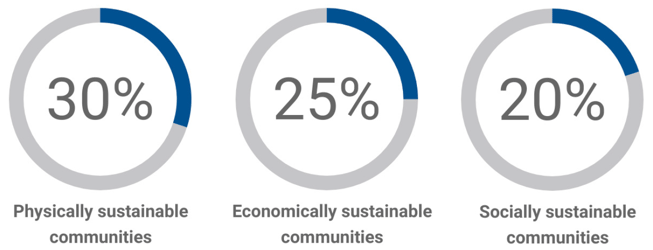
Priority is given to projects where the funding can be spent within a single financial year. However, organisations can apply for funding over more than one year – with a clear rationale explaining why this is needed. It is expected that the main infrastructure works, which are the focus of the RCGF support, will be underway within the year (or at least have gone through full procurement, with a successful contractor appointed and a legally binding contract signed). Where grant is requested over more than one year, the grant must be claimed according to the profile provided in the application form.
There is no minimum request, and projects can request 100% of the total eligible project costs – although leverage is considered when assessing applications.
2.4 RCGF monitoring and administration
RCGF funded projects are required to submit regular monitoring forms, in line with an agreed schedule. The routine requirement is that projects must submit a monitoring report at least every four months. At the end of the work, funded projects are also required to submit a final monitoring form and claim. A project completion form is required 12 months after the certificate of completion of building works has been issued.
Funding is drawn down in line with an approved profile and is usually paid in arrears – once projects have spent funds. Funds can sometimes be claimed in advance if projects have entered into a legal or binding contract to deliver the work, and evidence of this contract is provided. Projects are required to claim the RCGF grant in full within the financial year it was offered for.
2.5 RCGF awards
The first round of RCGF funding was in financial year 2014/15. To date, 138 projects have been recommended to receive an offer of grant, totalling over £138 million. This works out at an average of around £1 million, but the amount requested by different projects can vary significantly. In some circumstances, projects can request RCGF funding over more than one financial year.
Although 138 projects have been recommended to receive a grant, not all of the projects have been completed and six have been withdrawn (two in Round 3 and four in Round 4). The projects cover 29 of the 32 local authorities in Scotland. A summary of the awards per authority is below. A detailed table and list of projects awarded funding is included as Appendix 3.
Table 2.1: RCGF awards by year
| Round | Year | Number of projects recommended for support | RCGF grant awarded* | Average award level | Award range |
|---|---|---|---|---|---|
| Round 1 | 2014/15 | 22 | £27.6 million | £1.25m | £200k - £5.8 m |
| Round 2 | 2015/16 | 18 | £14.3 million | £797k | £200k - £1.6m |
| Round 3 | 2016/17 | 26 | £23.3 million | £960k | £290k - £2.9m |
| Round 4 | 2017/18 | 29 | £23.4 million | £871k | £335k - £2.5m |
| Round 5 | 2018/19 | 25 | £27.1 million | £1.1m | £100k - £4m |
| Round 6 | 2019/20 | 18 | £20.5 million | £1.1m | £150k - £2.3m |
*At the time of writing these are the actual awards for the 132 projects that went ahead – excluding the 6 withdrawn projects.
Figure 2.2: RCGF grant awarded by local authority area[11]
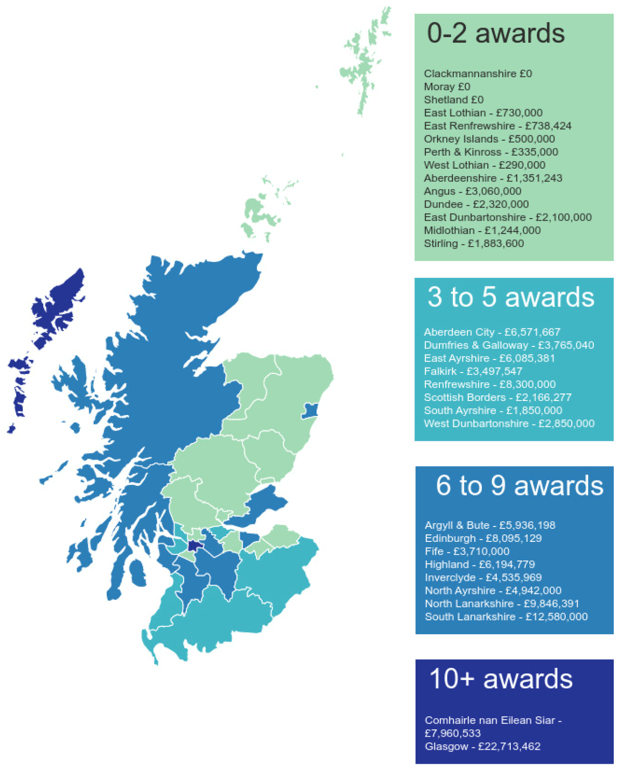
The RCGF awards are driven by the supply of applications from each local authority area, as well as decisions made by the RCGF Investment Panel in line with the selection criteria (see section 2.3).
The RCGF focuses on projects in areas which have high levels of deprivation and disadvantage. Deprivation and disadvantage can be defined in various different ways. The Scottish Government's official tool for identifying spatially concentrated areas of multiple deprivation is the Scottish Index of Multiple Deprivation (SIMD). Analysis of the correlation between RCGF awarded (in Rounds 1 to 6) and local and national share of deprivation within the local authority (based on the SIMD) is included within Appendix 3.
The analysis shows that some of the areas with the largest national or local share of datazones in areas of multiple deprivation received the largest shares of RCGF. However, there is not a direct correlation. Some areas with relatively low levels of spatially concentrated multiple deprivation also received relatively high levels of RCGF funding. Not all people and communities experiencing disadvantage live in spatially concentrated areas of high multiple deprivation. For example, two thirds of income deprived households do not live in the most deprived areas[12]. Some of these local authority areas were in areas facing other types of disadvantage – for example in fragile, remote and rural communities.
This analysis is provided to provide an indication of the correlation between local authorities with high levels of deprivation, and level of RCGF award. It should be noted that disadvantage is a wider concept than deprivation, and that not all people and communities experiencing disadvantage live in areas of high multiple deprivation.
2.6 Intended social outcomes
The focus of this research is on social outcomes and community involvement. When organisations applied to the RCGF, they were asked to set out their intended social outcomes. The core social outcomes which the Scottish Government wished to achieve through the RCGF were set out within the guidance accompanying the application form.
These social outcomes related to the Scottish Government Regeneration Strategy 2011 – Achieving a Sustainable Future. Together, the overarching purpose was to build socially sustainable communities.
The social outcomes are set out below. For the purposes of this report, they have been sorted into seven themes.
Figure 2.3: Social outcomes
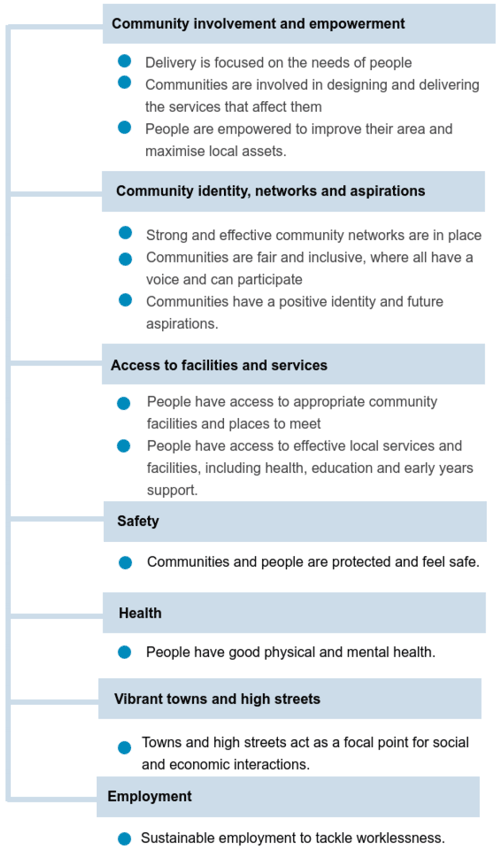
Across all funded projects, applications suggest that the projects had the potential to support more than 380 community facilities involving around 650 volunteers.
2.7 Intended physical and economic outcomes
While this research has focused on social outcomes, a key purpose of RCGF projects is to bring about physical and economic outcomes.
Scottish Government analysis of application forms for funded projects highlights that across the 132 projects which received an offer of grant from the RCGF to date[13], there was potential to:
- create or support around 10,700 jobs
- create or support around 6,000 training places
- bring 175 buildings back into use
- create or refurbish almost 200,000 square metres of buildings
- bring just over 100 hectares of land back into temporary or permanent use
- support more than 2,100 businesses or enterprises
- support around 200 energy or renewable projects
It is important to recognise that projects changed and developed over time, which in some instances may result in changes to the types or levels of projected physical and economic outcomes.
Scottish Government analysis of the available final reports and completion forms for all 132 projects (of which there were very few) found that it was not possible to compare anticipated physical and economic outcomes with actual outcomes.
2.8 Intended outcomes for the focus projects
Each of the 14 focus projects[14] intended to achieve a mix of physical, economic and social outcomes.
Figure 2.4: Intended mix of outcomes - focus projects
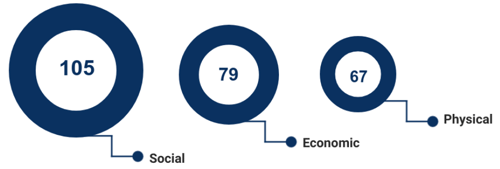
In total, each project selected an average of 18 intended outcomes, across the physical, economic and social themes. Projects were therefore working to achieve a wide range of changes in relation to building sustainable communities.
The most commonly selected physical outcomes related to quality design, well planned neighbourhoods, places with a positive appearance, and addressing vacant and derelict land and property. The most commonly selected economic outcomes related to providing access to jobs and support for business, providing learning and development opportunities, building a thriving private sector and social enterprise and ensuring sustainable employment and reduced welfare dependency.
This evaluation focused on social outcomes. Figure 2.5 below shows the social outcomes selected by the 14 focus projects.
Figure 2.5: Social outcomes selected by 14 focus projects
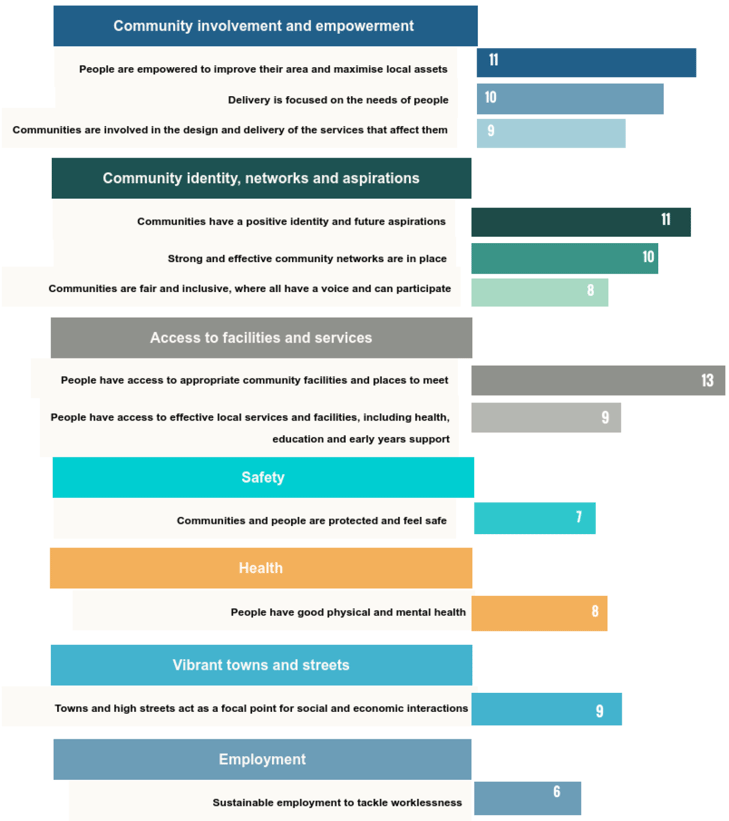
Note: One of the focus projects used its own phrasing to describe its social outcomes. These have been re-allocated to the relevant outcomes by Research Scotland.
Across the projects there was a strong focus on the social outcomes of providing access to facilities, focusing on needs, empowering people and building a positive community identity. There was slightly less focus on sustainable employment within projects' descriptions of their social outcomes.
Most of the focus projects also intended to achieve placemaking outcomes of:
- communities have a positive appearance and are places where people want to live, work and invest (11)
- well planned neighbourhoods and local areas, with accessible facilities and amenities (10)
- people have access to quality public spaces and appropriate greenspace (8)
Contact
Email: socialresearch@gov.scot
There is a problem
Thanks for your feedback